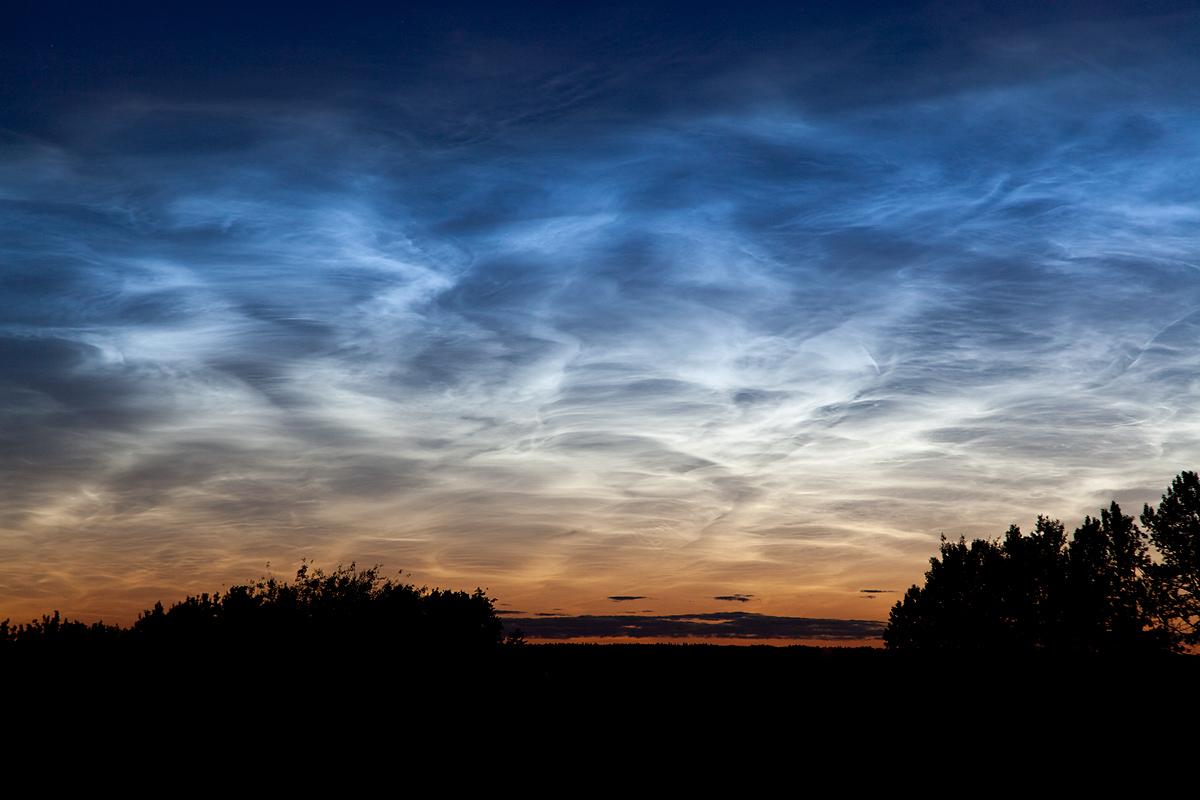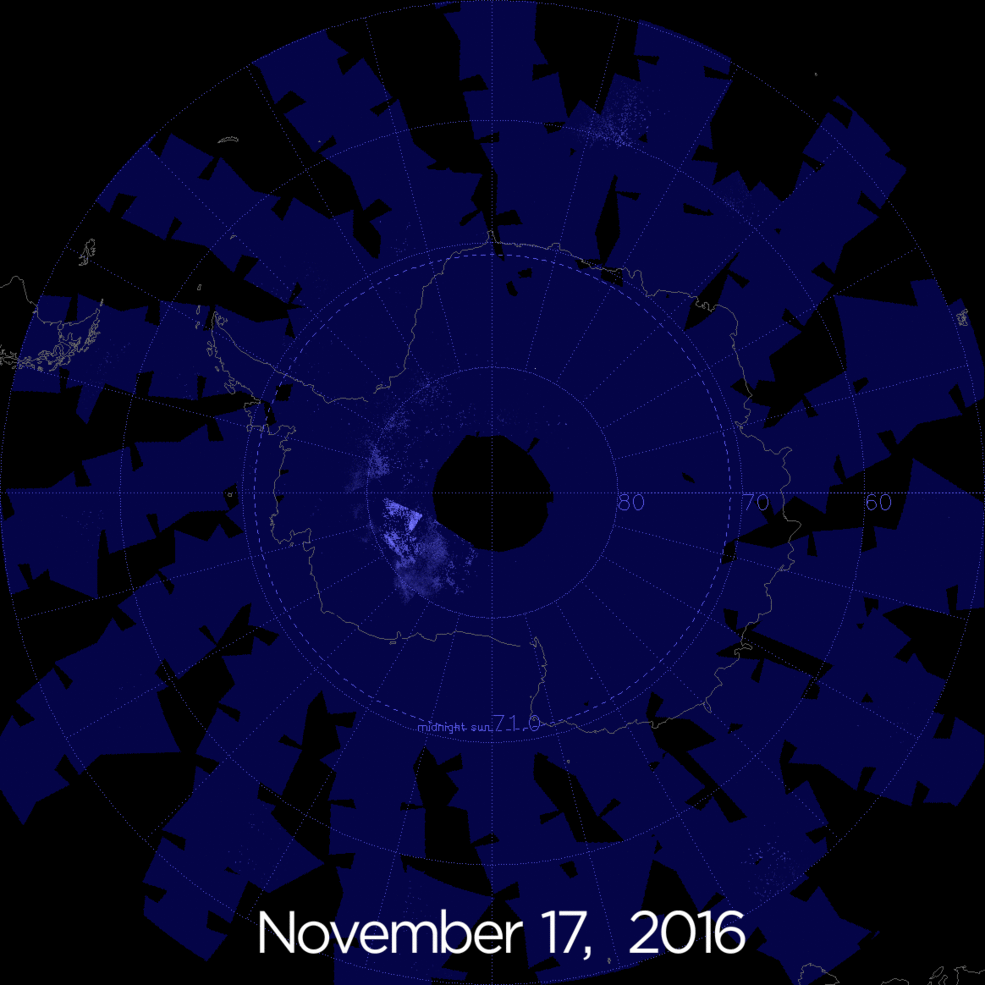Launched on April 25, 2007, NASA’s Aeronomy of Ice in the Mesosphere, or AIM, mission, has provided a wealth of new science on the dynamics and composition of Earth’s upper atmosphere. Designed to study noctilucent, or night-shining, clouds, AIM’s data have helped scientists understand a host of upper-atmosphere phenomena, from radio echoes to giant, planet-scale atmospheric waves.
“AIM started out studying clouds that form on the edge of space, about 50 miles above Earth, to understand why they form and how they vary,” said Jim Russell, principal investigator of the AIM mission at Hampton University in Hampton, Virginia. But he says that 10 years of data from AIM has far exceeded the initial expectations. “We’ve made great strides in answering this question and learned far more about the atmosphere than we ever imagined when the mission was conceived.”
Noctilucent clouds form in Earth’s mesosphere. They’re made of ice crystals, which reflect sunlight to give off the clouds’ signature blueish glow. Though scientists had ideas about how and why these clouds form before AIM launched, the mission’s 10 years’ worth of data have confirmed their origins.
“The accepted theory was that the ice formed around meteoric smoke — very small, nanometer-scale particles that are remnants of meteors burning up in the atmosphere,” said Diego Janches, project scientist for the AIM mission at NASA’s Goddard Space Flight Center in Greenbelt, Maryland. “With AIM, we were able to study the presence and variability of that smoke.”
Over the next few years, AIM will enter a new phase of science. Because of the way the spacecraft’s orbit has shifted over time, AIM is now in an ideal position to study gravity waves, oscillations in the air usually caused by weather and winds near Earth’s surface.
“These gravity waves affect the entire circulation of the middle and upper atmosphere,” said Cora Randall, principal investigator of AIM’s Cloud Imaging and Particle Size, or CIPS, experiment at University of Colorado Boulder. “These are really important for the global atmospheric structure and composition, and even affect the polar vortex.”
AIM’s CIPS instrument can detect tiny changes in ultraviolet light reflected off of Earth’s atmosphere about 30 miles above the surface. Those tiny changes can reveal the gravity waves coming from below, much like ripples on the surface of a pond can be traced back to a dropped pebble.
AIM’s new measurements of these gravity waves, along with observations from ground-based missions and other satellite missions, will give scientists new insight into the behavior of the uppermost atmosphere at the edge of space.
“By taking these measurements at the same time, we’ll hopefully be able to link processes in the stratosphere to changes in the thermosphere even higher up,” said Janches.
AIM’s data have led to more than 200 papers on Earth’s upper atmosphere. A handful of key scientific discoveries:
- Overturning assumptions about the sun and noctilucent clouds: Observations from the 1980s and ’90s suggested that the appearance of noctilucent clouds is linked to the sun’s activity, which rises and falls in about 11-year patterns. But AIM’s data tell a different story: noctilucent clouds have been steadily increasing over the past decade, despite the sun’s regular changes in activity. The precise reason for this is still unknown.
- Noctilucent cloud and greenhouse gases: Scientists suspected that increased sightings of noctilucent clouds could be related to increasing greenhouse gases. Combining AIM’s data with 36 years of measurements from satellite instruments showed a correlation between more frequent noctilucent clouds and increases in water vapor, a greenhouse gas, and decreasing upper-atmosphere temperatures — a side effect of warming near the surface.
- Meteors help create noctilucent clouds: The ice crystals that form noctilucent clouds must form on a foundation of some kind. AIM’s data showed that this base is actually smoke from meteors — tiny microparticles produced when meteors burn up in Earth’s atmosphere.
- Tracking meteoric smoke: Before AIM’s launch, scientists primarily watched meteoric smoke — the tiny particles created when meteors burn up in the atmosphere — from just a few viewpoints with sounding rockets. AIM’s measurements have given scientists a new tool to watch this meteoric smoke, revealing for the first time the dynamics of how meteoric smoke moves through the atmosphere.
- Understanding the upper atmosphere: AIM helped scientists track how heat moves in the upper atmosphere, showing that heating in the mesosphere is more likely linked to circulation in the atmosphere rather than direct heating from the sun.
- Studying atmospheric waves caused by Earth’s rotation: AIM measures planetary waves, planet-scale waves caused by Earth’s rotation, that can influence weather across the globe. Over its 10-year mission, AIM has observed three of the four most extreme springtime planetary wave events seen since satellite observations began in 1978, raising questions about possible changes in the dynamics of the atmosphere.
- Teleconnection between the poles: AIM’s data showed that conditions in the stratosphere near the North Pole influence conditions in the mesosphere near the South Pole days or weeks later — even going so far as to influence the transition between seasonal conditions.
- How Earth’s weather affects the upper atmosphere: AIM’s measurements have also helped scientists track how air in the atmosphere moves vertically, as well as between the hemispheres. This helps scientists understand how events near Earth’s surface — like thunderstorms — might trigger changes in the upper atmosphere.
- Understanding the atmosphere from bottom to top: This new understanding of vertical linkages in the atmosphere was integrated into the first weather model that describes the entire atmosphere from the surface all the way to the upper mesosphere.
- The source of radar echoes: AIM solved the mystery of radar echoes in certain regions of the atmosphere during the summer. The same ice layer that produces noctilucent clouds is to blame for radar echoes, and the size of the ice crystals can even play a role.
Related
By Sarah Frazier
NASA’s Goddard Space Flight Center, Greenbelt, Md.
































